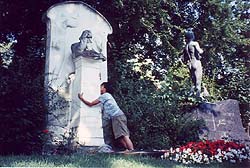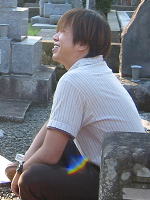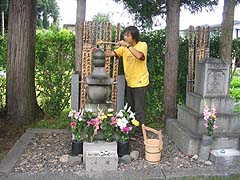| |
|
 |
 |
 |
WEEK
3
A PILGRIM'S PROGRESS
Tomb
raver
By SETSUKO KAMIYA
Staff
writer
Teenage years are often a time of confusion. But for one
37-year-old who goes by the pen name Kajipon Maruko Zangetsu, it was a time of
torment due to family problems and a majorly broken heart.
 |
| Self-styled hakamaira Kajipon Maruko Zangetsu shows his
feelings in 1994 on his first "pilgrimage" to the grave of German composer
Johannes Brahm in Vienna, Austria, which he revisted in 2002. (Photos courtesy
of Kajipon Maruko Zangestu) |
To escape his painful reality, Kajipon sought refuge in the world of
literature and art. He read and read, from Osamu Dazai to Goethe, and absorbed
himself in the music of Beethoven and Mozart.
"I realized that they were all so lonely and sad. Writing and composing were
ways to conceal that," said the Osaka resident. "But they taught me that I could
go on with life despite my sorrow, and that the world and people were beautiful
after all."
At age 19, by which time he was an out-and-out arts junkie, Kajipon flew to
Leningrad in the U.S.S.R. (now St. Petersburg in Russia) to visit the grave of
the writer Feodor Mikhailovich Dostoevski, whose "Crime and Punishment" had
inspired him. "I wanted to thank him in person for saving my soul," Kajipon
said.
 |
| Kajipon Maruko Zangetsu
|
But Dostoevski literally changed his life.
"As I stood before his grave, his writings became so vibrant. It felt as if
he was talking to me," Kajipon recalled. "Until then, he was just a name, but
his existence in this world suddenly felt so real."
Shocked but delighted by this realization, Kajipon then hit on an idea that
has steered his life ever since. "If this happened with Dostoevski," he
explained, "I thought that the same thing must occur with Soseki and
Shakespeare. There was no way that I wouldn't visit them, too."
 |
| Kajipon at the grave of poet and children's story writer
Kenji Miyazawa in Hanamaki, Iwate Prefecture, in July 2004.
|
So it was that Kajipon became a pilgrim -- or what he calls a "hakamaira," a
word he invented by combining the Japanese word hakamairi (grave visit) with the
sound of the English suffix "er" to signify someone who visits graves.
And certainly he's nothing if not a devoted hakamaira, as, since that first
pilgrimage in 1987, he has visited the graves of 600 "heroes and heroines" in 40
different countries. Among those have been the last resting places of the movie
director Akira Kurosawa, 18th-century ukiyo-e artist Katsushika Hokusai, Latin
American revolutionary Ernesto Che Guevara, Hollywood actress Audrey Hepburn,
19th-century French entomologist Jean-Henri Fabre, 16th-century Italian
astronomer Galileo Galilee and the 20th-century Chinese writer Lu Xun, just to
name a few.
As amazingly diverse as even that small sample is, Kajipon is no aimless,
ghoulish collector of reflected glories. In fact, he makes it a strict rule not
to visit the grave of anyone whose works he is not familiar with -- or hasn't
been impressed by. "This isn't sightseeing; that would be very rude," he
insists.
Not that he isn't interested in the living, too. By way of paying his
respects to numerous contemporary writers and cartoonists he admires, he fires
off fan mail -- though to date he has not met any of them.
Candidly, Kajipon -- who used to do all kinds of jobs to pay for his trips
but is now a full-time freelance writer -- admits there is an element in being a
hakamaira that's similar to chasing idols. "What (popular idol group) SMAP or
(heart-throb Korean actor) Bae Yong Joon are to some people are what Bach and
Goethe are to me," he said. "I don't care if they're deceased. I just want to
get close to them, and the closest place is their graves."
But locating graves can often be a painstaking business, and Kajipon often
has to do extensive research using biographies, guidebooks, TV shows and the
Internet to come up with clues. Then, when he is abroad, he heads to tourist
information centers to seek out yet more information -- often confounding
officials more used to fielding inquiries about regular tourist spots.
Undeterred, this hakamaira has the patience to continue his quest wherever he
needs to, whether at museums, music halls or used-book stores.
From experience, Kajipon explained that in many countries graveyards tend to
be on the outskirts of cities. In the case of his pilgrimage to the grave of
Hungarian-born American war photographer Robert Capa in 2000, for example, he
pinpointed a graveyard in Westchester, N.Y. -- but then couldn't get there
because there was no public transport and it was in a no-hitchhiking zone.
Sadly, his schedule that time forced him to give up.
Three years later, Kajipon returned -- and walked to Capa's grave, which took
him four hours one way. But even on reaching the graveyard, Kajipon's troubles
were not over, as he still had to try to locate the tomb among hundreds of
others. Fortunately, his determination was finally rewarded when he asked a
local woman for help, and she kindly fetched a friend who showed him where it
was.
There have been bad experiences, too, and Kajipon has been robbed several
times. Interestingly, however, he said he never feels spooked in graveyards --
"because they are holy places."
On finally arriving at his target tomb, Kajipon said he normally sits down to
have a conversation with the occupant. "I tell him or her what I loved about
their works, and let them know that they've made it possible for me to believe
in others," he said. Often, he added, this can take hours, involving the
offering of incense and flowers, and even readings from their works. Then
there's the photo session. Kajipon never fails to shoot pictures of the graves,
and often has himself in the frame, too.
Since 1999, when he launched his Web site (http://kajipon.com), all this has been out there in cyberspace for anyone to see. What browsers
will find is not only an incredible huge and varied list of the tombs he's
visited, but also detailed descriptions of who they were, what they accomplished
and -- in what Kajipon considers an important part of his mission -- why
he was attracted to them. "I think my pilgrimages will enable others to recognize there is something
wonderful about the person who influenced this guy from Osaka to go this far,
and that may stir their interest in their works," he said -- adding that his
wife is among his avid readers.
As his readership has grown over the years, it was through his Web site that
Kajipon became a freelance writer after receiving offers from magazines.
Recently, he's also had a book published on graves he's visited in Tokyo and
Kamakura in Kanagawa Prefecture.
At the moment, Kajipon is much further afield, having left for Europe on June
15 on his eleventh pilgrimage. This time, over 2 1/2 months, he plans to visit
no fewer than 120 graves in a marathon trip through 21 countries.
"Visiting people's graves made me understand that we will all die one day,
and a lot of people have actually died when they were my age," he observed just
before leaving last week. "And I don't want to put off until tomorrow things
that I can do today."
Right now he's in France -- probably on his way to drop in on Vincent van
Gogh once again, before heading off to commune with Leonardo da Vinci, then
Henri de Toulouse-Lautrec.
The Japan Times: June 19, 2005
(C) All rights
reserved
|
 |
 |
 |
|
|
|

|
The Japan Times ONLINE
E-mail News
|
 Latest news, business, sports
and arts from Japan delivered to you! Subscribe now! Latest news, business, sports
and arts from Japan delivered to you! Subscribe now! |
|
|
 |
|
Highlight
|
Genki Text Books
 An Integrated Course in Elementary Japanese
containing grammar exercises, listening practices, practice for kanji, and more! An Integrated Course in Elementary Japanese
containing grammar exercises, listening practices, practice for kanji, and more!
|
|
|
|
|
The Japan Times Cartoons
!
 |
|

